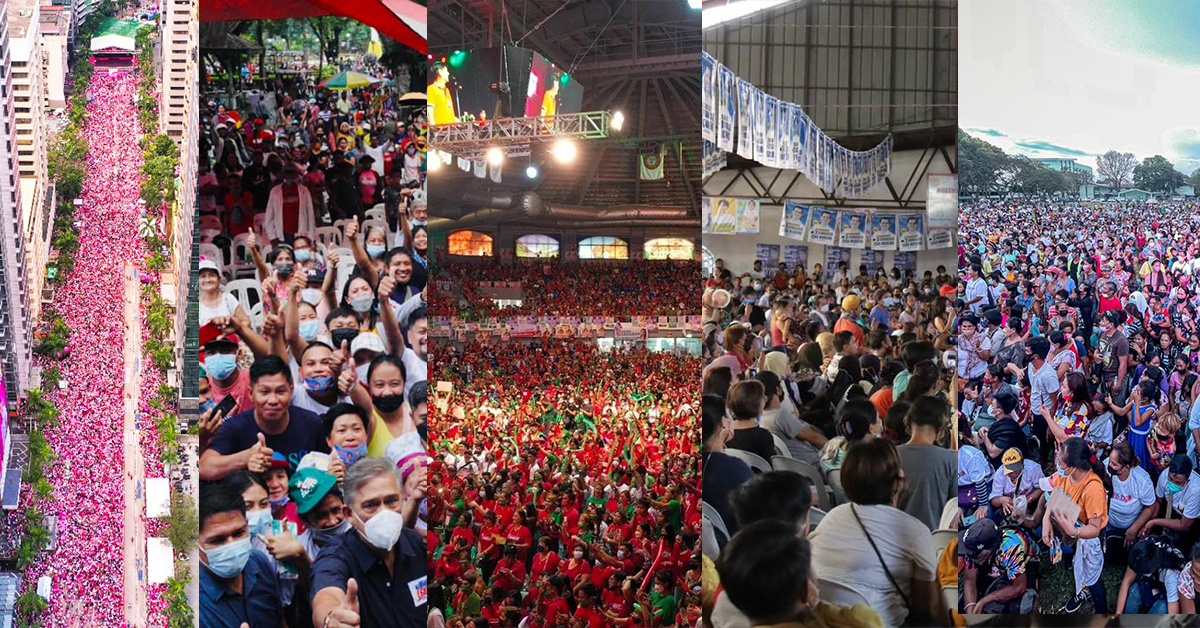As crowds converge in political rallies this election season, it is crucial to understand how measuring crowd sizes works beyond counting attendees.
Photo Courtesy: Leni Robredo Facebook page/Ping Lacson Facebook page/
Bongbong Marcos Facebook page/Isko Moreno Facebook page/Manny Pacquiao Facebook page
Crowd estimates help assess the preparedness of buildings and infrastructure to accommodate sums of people. Gauging capacity and infrastructure integrity also helps city planners in building future projects to prevent crowd-related disasters.
With the campaign season’s debates heating over crowd estimates for campaign rallies, we ask: how do we crunch the numbers for crowd estimates?
Photo Courtesy: Leni Robredo/Facebook page
Although determining the number of people attending monumental events like political rallies or protests looks tough and a nearly impossible task, it’s actually not that hard to get fairly accurate findings with the right data and means.
Methods Use for Crowd Counting
UC Berkeley journalism professor Herbert Jacobs coined the concept while attempting to estimate the scale of Vietnam War protests outside his office window in the 1960s.
Because the ground outside was gridded, Jacobs could count how many protesters were in each square on the grid and multiply by the number of squares. As a result, crowds in places like the National Mall, which are laid out in a natural grid pattern, can be easier to count.
Photo Courtesy: Bongbong Marcos/Facebook page
The Jacobs Approach is the most used method for estimating the number of individuals in an immense crowd: if a rally location isn’t conveniently gridded, knowing the overall area and the crowd density will do. The most tightly packed crowd, known officially as “mosh pit density,” has one person per every 2.5 square feet. It’s the crowd wherein you could pick your feet off the ground and stay upright just fine. This population density is considered a tight upper limit; any crowd counts that allot lesser space per person are considered physically impossible.
Photo Courtesy: Isko Moreno/Facebook page
There is one person for every 4.5 square feet in a more breathable crowd, putting you elbow-to-elbow with your mates. During a light crowd, there might be one person for every 10 square feet.
By dividing the area into sections with higher vs lower crowd density and multiplying by their relative areas, very accurate crowd estimations can be determined, usually within 10-20 percent.
The boundaries, or where rally goers stop and non-attendees begin, can be difficult to assess in massive crowds. The most accurate estimations are based on a combination of multi-directional aerial photography acquired from satellites, helicopters, or balloons that shows the crowd’s expanse, as well as photographs taken from the ground that show the density of people up close.
Photo Courtesy: Ping Lacson/Facebook page
We can resolve some of these issues using complex computer algorithms that consider characteristics such as sloped lawns, which might give the impression of more people than are actually there. Such changes in landscape are fairly well-mapped, thanks to databases like Google Earth, and may thus be appropriately considered.
Why is Crowd Counting Important?
Essentially, estimating crowd size helps keep enormous groups under control. Event organizers and officials can plan how to manage traffic in the region, as well as how many medical response personnel will be required in the event of an emergency and how much security to hire. Crowd size is also required for media news reporting and historical documentation of the event.
Photo Courtesy: Manny Pacquiao/Facebook page
For all event organizers, above ensuring that we have a huge turnout in our events, let’s make sure of the capacity and structural integrity of the venue to ensure everyone’s safety.
Subscribe now to see more content like this in the future!
CITATIONS:
- Stierwalt, S. (2017, January 24). How Do You Estimate Crowd Size? Quick and Dirty Tips. Retrieved March 24, 2022, from https://www.quickanddirtytips.com/education/science/how-do-you-estimate-crowd-size?page=1&msclkid=9b3fc033ab6411ec813867b19df3d976
- Melina, R. (2010, September 4). How Is Crowd Size Estimated? LiveScience. Retrieved March 24, 2022, from https://www.livescience.com/8578-crowd-size-estimated.html?msclkid=9b40fb49ab6411eca3c86e7eb9ee1f33
![]()











